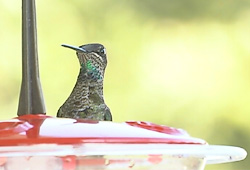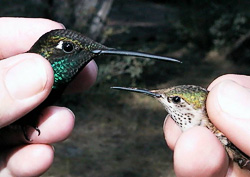
 Louisiana's First Magnificent, an immature male in West Slidell; November, 2004
Louisiana's First Magnificent, an immature male in West Slidell; November, 2004
|
Mag's are trap-liners! Unlike most of our local hummers who stake out and guard flowers and feeders, Magnificents move from one site to another to another throughout the day, sometimes staying at a single location for just a few seconds. I guess, being the 800-pound gorillas of North-American hummingbirds, they don't need to guard territories! This makes sighting and documenting them really difficult. A friend of mine spent over 20 hours letting his video camera run, just to get the few minutes we have documenting this bird. Sometimes we have to just accept what Ma Nature gives us. |
  Louisiana's First Magnificent, an immature male in West Slidell; November, 2004
Louisiana's First Magnificent, an immature male in West Slidell; November, 2004
|
When I received the call, I was naturally skeptical but the decription...a dark hummingbird with a green throat, twice the size of a Ruby-throated...sounded really good for a Magnificent. I got to Slidell as quickly as I could and hoped to trap the bird and document it with in-hand photographs. After four long hours of watching and waiting, the bird did not reappear.
On my next trip, I was lucky enough to get some really good looks at the bird when it flew up to my trap. Woo-Hoo!!! It was indeed an immature male Magnificent! Unfortunately he didn't enter the trap and flew away. Realizing that easily catching the bird to document it was not going to happen, I decided that it was more important to get photos or video for documentation and I knew just the person to do the job.
Bill Wayman spent many long hours over several days shooting video of an empty feeder, just waiting for the Mag to briefly swoop in for a drink. Fortunately, Bill got lucky and managed to get images of not only the bird drinking from the feeder but also sitting ... or should I say posing ... in a wax myrtle on the other side of the driveway.
Morgus*, as the homeowners dubbed him, was an irregular visitor to this Slidell home from November 10th to November 29th. On the morning of the 29th, Morgus came in for a long drink, then perched for five minutes in the top of a crepe myrtle. His reverie was rudely interruptted when an Eastern Phoebe ventured onto the scene. Much to our horror, the Phoebe flew up and viciously attacked Morgus. The aerial battle was ugly and noisy with both birds squealing. Thank goodness Morgus came away from the fight just fine. He sat for a few moments on his favorite perch within the wax myrtle rearranging his ruffled feathers. At the time, when he flew away, we didn't realize that was the last time we would see Morgus.
We sure hope he comes back next fall!
| * Okay. If you're not from New Orleans, you're not going to recognize this. During the early 1960's, a local weekend late-night monster-movie television show was hosted by a "mad doctor" named Dr. Momus Alexander "The Magnificent" Morgus. You kind-of had to be there. Click here if you wish you were. Hmmm. I guess the good Doctor would point out this bird is Louisiana's second Magnificent. |
What to look for
This is an immature, hatching-year male. Note his long neck, long bill and flat forehead.
In the images and video here, you can see his incomplete gorget (iridescent throat) and the top of this head, and the rough tweedy look of his chest feathers. When he has his adult plumage, his gorget will be bright green or turquoise (depending on how the light hits it), his head vibrant violet, and he'll become the "Dark Knight" of his reputation.
  Male Magnificent, immature male Calliope; Spirit Canyon, NM; August 2001
Male Magnificent, immature male Calliope; Spirit Canyon, NM; August 2001
|
Here's video!
Watch for flashes of green on his throat and violet on his crown! The scaly pattern on his breast is typical for an immature male Magnificent.
The darker patch near his shoulder shows how his whole underside will look after he completely molts into his adult plumage.
Below are two links. The first is a larger more detailed video, the second a smaller, cruder one more suitable for access over a dialup connection. Here's what we suggest:
| Broadband (5MB) Dialup (0.5MB) |
In all cases, once you've downloaded enough of the video, it should start streaming through Windows' Media Player (though on some systems you may have to complete the download before is starts to pley). Once you've completed the download, you should be able to save it to your local disk by selecting File>Save Media As... Of course, you'll want to make a note of exactly where on your local disk you save it. |
| ||||
| Browser Note: Firefox, Mozilla, and MS Internet Explorer should transfer automatically to Windows Media Player for viewing these videos. Other browsers may require some configuration. | ||||||